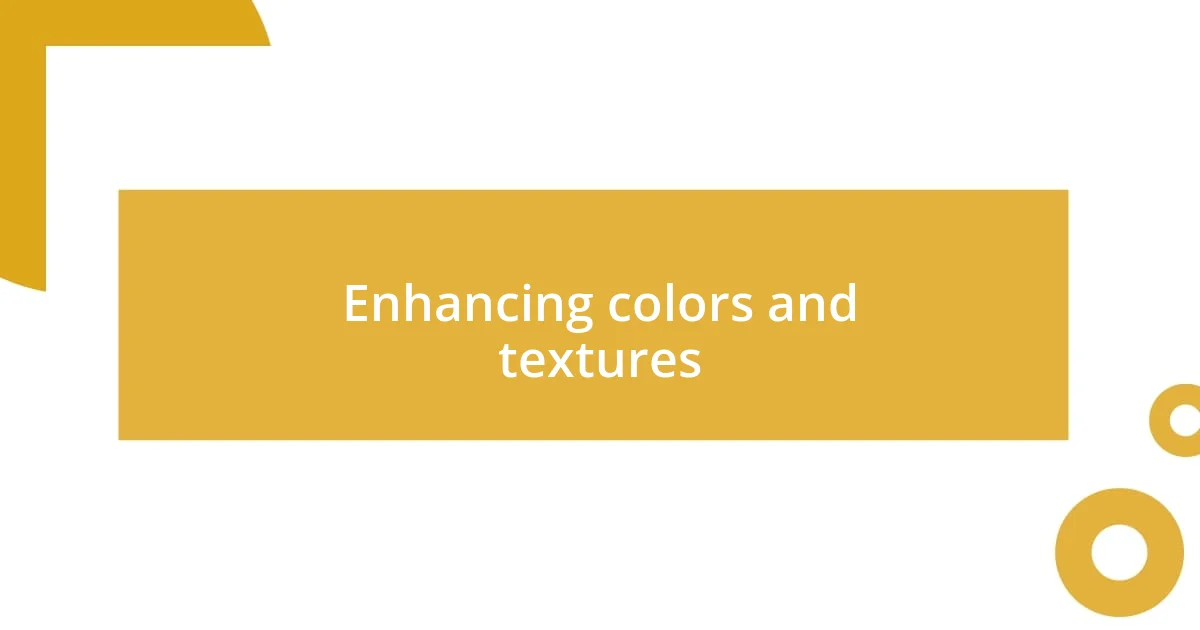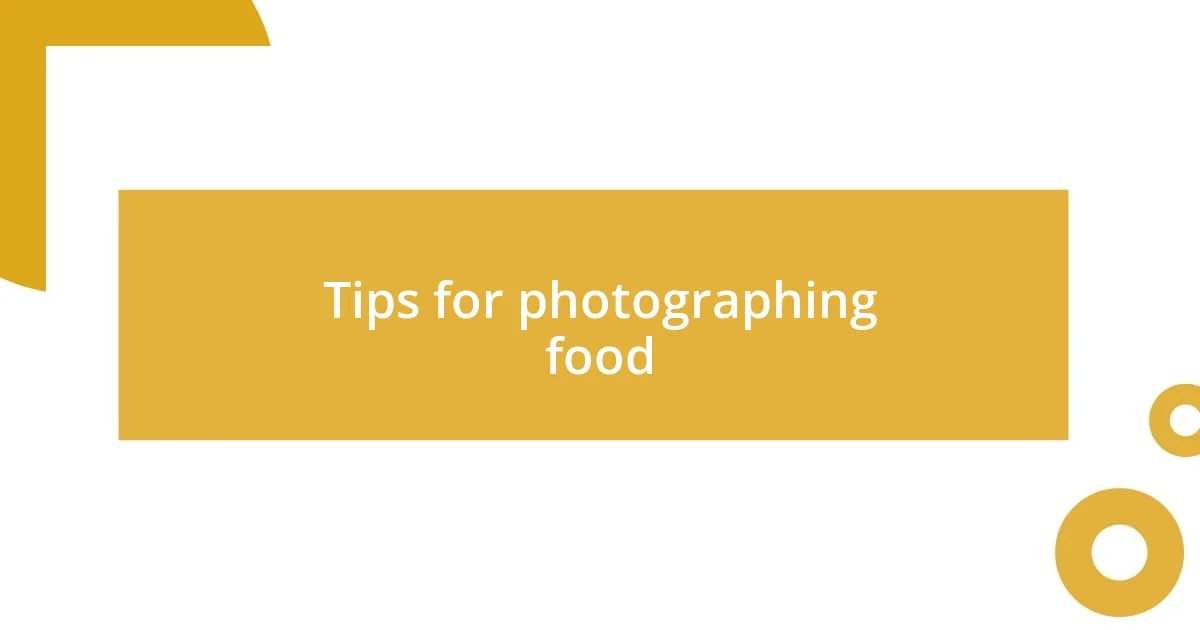Key takeaways:
- Food presentation enhances the dining experience by combining aesthetics, taste perception, and emotional connections.
- Techniques such as layering, using contrast, and embracing negative space create visually appealing dishes that excite anticipation.
- Themed presentations and thoughtful serving dish choices can elevate meals, turning ordinary dining into memorable experiences.

Understanding food presentations
Food presentation is an art that goes beyond merely serving a meal; it’s about creating an experience. I remember the first time I noticed the impact of presentation—I was at a small bistro, and the carefully plated dish seemed to beckon me to enjoy it. Isn’t it fascinating how a simple drizzle of sauce can elevate a dish from ordinary to extraordinary?
When I think about food presentations, I can’t help but reflect on how colors can affect our perception of taste. I once prepared a vibrant salad with fresh greens, ruby-red tomatoes, and bright orange carrots. The visual contrast made every bite feel like a celebration. Have you ever noticed how our eyes tend to eat before our mouths do?
Texture also plays a significant role in how we perceive food. A well-placed garnish can transform a dish into a masterpiece, offering a tactile experience that excites anticipation. I’ve experimented with different textures in my cooking, and it’s amazing how adding a crunchy element can enhance both flavor and enjoyment. Isn’t it thrilling to think about how presentation can connect not just to our taste buds, but to our emotions as well?

Importance of visual appeal
When food is beautifully presented, it can awaken our senses and spark an emotional connection. One evening, I attended a wedding where the dessert table was a vibrant display of colors and shapes. As I stood there in awe, I found myself savoring each piece not just for its flavor but for its artistry. It was a reminder that what we see can often intensify our anticipation and pleasure.
Visual appeal also plays a crucial role in influencing our taste experience. I recall dining at a restaurant where the chef artfully arranged a dish with minimalistic flair. The use of negative space on the plate left a lasting impression on me, making each ingredient stand out. It’s fascinating how the arrangement can enhance not only the aesthetics but also the overall flavor perception. Doesn’t it make you wonder how much our judgement is swayed by appearances?
Moreover, the psychology behind food presentation cannot be understated. A well-composed dish can set a mood, turning an ordinary meal into a memorable occasion. I remember hosting friends for dinner and placing extra emphasis on how each course looked. Their delight was tangible, and it made me realize that presentation is not just about aesthetics; it’s about creating an entire experience that lingers in our minds long after the meal is over.
| Aspect | Importance |
|---|---|
| Emotional Connection | A beautiful presentation can evoke feelings of excitement and pleasure. |
| Flavor Perception | The way food is arranged can enhance how we perceive its taste. |
| Experience Creation | Visual appeal transforms meals into memorable experiences. |

Techniques for beautiful plating
One technique I love to use is the art of layering. It adds depth and intrigue to the plate. For instance, when I prepared a layered vegetable stack, I chose to alternate colors and textures—zucchini, roasted red peppers, and creamy goat cheese. Each layer peeked through, creating a visual feast that made my guests excited to dig in.
- Use Contrast: Combine different colors and textures for interest.
- Play with Height: Encourage a vertical presentation for eye-catching appeal.
- Choose the Right Plate: A simple white plate can make colors pop.
- Garnish Thoughtfully: A sprinkle of herbs or a drizzle of sauce can elevate your dish.
Another approach I appreciate is the concept of negative space. Leaving some parts of the plate untouched encourages the eye to focus on the food presented. I once plated a seared salmon with a vibrant pea puree on one side and a sprinkle of microgreens on top. The empty space around the dish made it feel elegant, highlighting the beautiful colors and freshness of the ingredients. It transformed an ordinary dinner into something memorable, showing how less can truly be more in food presentation.
- Balance Elements: Distribute ingredients evenly on the plate.
- Focus on Color: Incorporate diverse colors to catch the eye.
- Utilize the Plate Edge: Using the rim of the plate can create a refined look.

Choosing the right serving dishes
When it comes to choosing the right serving dishes, I often reflect on how they can shape the entire dining experience. For example, during a brunch I hosted, I opted for elegant glass serving platters for my pastries instead of standard ceramic ones. The transparency of the glass allowed the pastel hues of the baked goods to shine through, creating a cheerful atmosphere that instantly lifted the mood. Isn’t it amazing how a simple switch can elevate even the most familiar foods?
Size and shape matter more than you might think. I recall preparing a vibrant salad once, and I decided to serve it in a shallow, wide bowl rather than a deep one. The wide surface area beautifully showcased the colors and textures, inviting my guests to indulge right away. Have you ever noticed how certain dishes seem to call out to you? This effect can heavily depend on how they’re served.
Don’t underestimate the importance of theme and purpose in your dish selection. When I was planning a family gathering, I remembered that my grandmother had her special vintage china reserved for special occasions. Using those plates not only made the meal feel extraordinary, but it also sparked nostalgic conversations at the table. Could it be that the dishes we choose are just as integral to the meal as the food itself?

Enhancing colors and textures
One of my favorite ways to boost the appeal of a dish is by embracing vibrant colors and varied textures. I once made a beet and citrus salad, showcasing deep purple beets paired with bright orange segments and crunchy walnuts. The stark contrast between the colors was mesmerizing, making the dish not just a salad, but a true visual delight. Don’t you think the aesthetics of food can stir our emotions and excite our taste buds even before the first bite?
Textures play just as important a role as colors in creating an appetizing presentation. Recently, I served a creamy avocado toast topped with crispy radish slices and a sprinkle of pomegranate seeds. The smoothness of avocado combined with the crunch of radishes created a delightful interplay that made each bite interesting and enjoyable. Have you ever considered how the feel of food—its crunchiness, creaminess, or tenderness—can elevate the whole experience?
Another technique I’ve found effective is utilizing natural ingredients in their raw form. One time, while cooking for friends, I arranged a cheese platter with an array of cheeses, fresh herbs, and colorful fruits. The juicy red strawberries and bright green basil not only adorned the cheese but signified freshness and quality. When I look back at that moment, I realize how food can become an artwork. Isn’t it fascinating how the visual appeal can enhance flavorful combinations?

Creating thematic presentations
Creating thematic presentations can truly transform a meal into an experience. I remember a cozy winter dinner I hosted, where I chose a rustic farmhouse theme. To enhance this atmosphere, I served hearty, seasonal dishes on wooden boards and decorated the table with pinecones and simple white candles. The warmth of the natural elements wrapped us in a comforting ambiance, making us savor each bite even more. Have you ever noticed how a theme can set the whole tone for a gathering?
Another memorable instance was when I prepared a tropical-themed brunch. I used bright, colorful dishes that echoed the island vibes, serving colorful fruit salads in coconut bowls and offering drinks in vibrant tiki mugs. The visual connection between the food and the theme transported my guests to a sunny beach, despite being in the middle of the city! This experience reminded me how crucial it is to align your presentations with the mood you wish to create.
Moreover, I find that incorporating an unexpected element can leave a lasting impression. For instance, at a recent dinner party, I served a classic Italian dish but presented it with a twist—a modern, minimalist design that emphasized the fresh ingredients. Paired with some playful, gourmet lighting, the meal felt innovative yet familiar. Isn’t it inspiring how infusing creativity into thematic presentations can make even traditional dishes feel fresh and exciting?

Tips for photographing food
Capturing the essence of food in photographs is an art that deserves thoughtful consideration. One trick I always utilize is natural light; it can dramatically enhance the dish’s colors and details. I recall photographing a decadent chocolate cake by a window to let the afternoon light pour in. The rich, glossy frosting shimmered, making it incredibly tempting. Have you ever noticed how light completely transforms the way we view food?
Another invaluable tip is experimenting with angles. Sometimes, simply changing where you shoot from can reveal stunning perspectives. I remember a time when I tried shooting a colorful poke bowl from above, showcasing the vibrant layers of toppings. The circular arrangement created a feast for the eyes, making it look like a work of art. What’s your favorite angle to capture those delectable details?
Lastly, don’t shy away from props. I often incorporate utensils, napkins, or even a sprinkle of herbs around the dish to add context and storytelling to my food photos. For instance, when I photographed a cozy soup served in a rustic bowl, I placed a warm, patterned napkin beside it and added a spoon. This simple addition made the image more inviting, as it hinted at the comforting experience of enjoying the meal. Have you thought about how props could elevate the atmosphere of your food photography?















